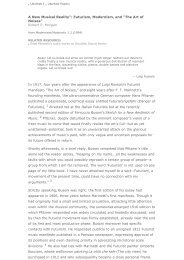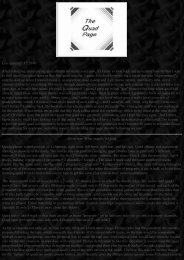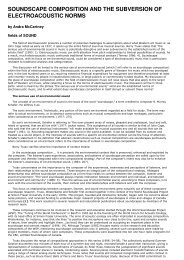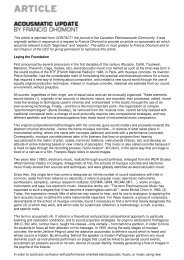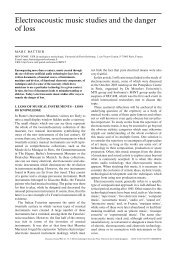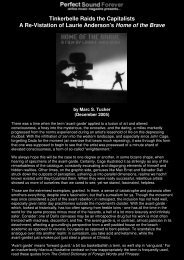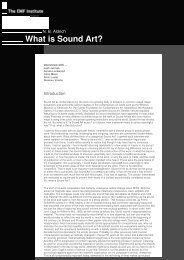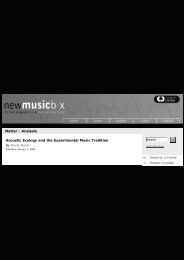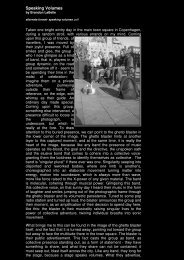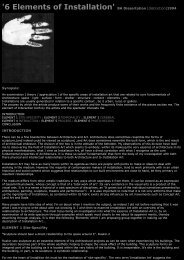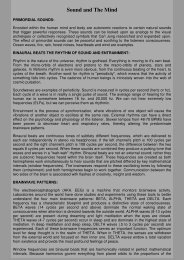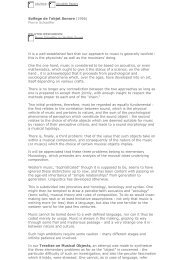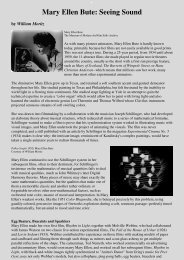'Sound art, radio art,and post-radio performance in Australia ...
'Sound art, radio art,and post-radio performance in Australia ...
'Sound art, radio art,and post-radio performance in Australia ...
Create successful ePaper yourself
Turn your PDF publications into a flip-book with our unique Google optimized e-Paper software.
have transformed sonic histrionics <strong>in</strong>to an <strong>art</strong>form, while others, such as Laurie Anderson, have captivated audiences<br />
with consciously accessible confessional anecdotes, 3l Walwicz works between these two poles, elucidat<strong>in</strong>g <strong>and</strong><br />
accentuat<strong>in</strong>g the sound value of her text by the modulation of the tonal range of her voice, <strong>and</strong> gestur<strong>in</strong>g towards<br />
emotion <strong>and</strong> confession <strong>in</strong> her own terms, rather than opt<strong>in</strong>g to make them perfectly explicit.<br />
Paradoxically, this k<strong>in</strong>d of seem<strong>in</strong>gly private aesthetic can have surpris<strong>in</strong>gly public impact. Ponder<strong>in</strong>g upon this<br />
possibility with reference to the way <strong>in</strong> which his own poems are 'completely personal, absolutely 100% subjective', the<br />
American poet John Giorno expla<strong>in</strong>s:<br />
When it works, it's like the subjectivity becomes the objectivity. It becomes the subjectivity of the audience,<br />
so it's what the audience wants to hear ... So it's not subjective <strong>in</strong> the sense that it's just me - it's everyone <strong>in</strong><br />
the audience, <strong>and</strong> it becomes completely objective. 32<br />
In much the same way, Ania Walwicz reports that her own highly subjective texts seem to overlap with her readers'<br />
experience, <strong>in</strong> the sense that they provoke the same evocative <strong>in</strong>tonation when read aloud by others. Discuss<strong>in</strong>g a series<br />
of ten 'colour' poems, 'each deal<strong>in</strong>g with a p<strong>art</strong>icular level of feel<strong>in</strong>g or be<strong>in</strong>g', <strong>and</strong> each written to 'enact that p<strong>art</strong>icular<br />
state of feel<strong>in</strong>g with<strong>in</strong> me' <strong>in</strong> terms of a 'p<strong>art</strong>icular form of tone', Walwicz recounts:<br />
I asked other people to read my work to see how it would turn out whether I was just project<strong>in</strong>g the sound<br />
value onto it. I asked them to read it without formally hav<strong>in</strong>g heard it read by me. And <strong>in</strong> actual fact they did<br />
slot <strong>in</strong>to a form of read<strong>in</strong>g which I actually do myself.<br />
The follow<strong>in</strong>g l<strong>in</strong>es from Red - an 'angry' monologue from this series - gives some idea of the p<strong>art</strong>ially private, p<strong>art</strong>ially<br />
public, qualities of these poems:<br />
kill cow hang butcher am angry hot head big ideas stronger know what bloody mary hates me look what fell<br />
over hurt knee what to do bright colour put b<strong>and</strong>age around don't want to see now look bag big th<strong>in</strong>gs kills<br />
wife redhead <strong>in</strong> my house is jealous so jealous tulip is loud apple is ok dwarf is nasty peaked hat knife <strong>in</strong> gut<br />
was murderer eats children ...33<br />
As Ania Walwicz remarked, while p<strong>art</strong>icipat<strong>in</strong>g on a <strong>radio</strong> forum simultaneously recorded <strong>in</strong> Melbourne, Sydney <strong>and</strong><br />
Brisbane, her work encompasses a variety of genres <strong>and</strong> motivations:<br />
Not everyth<strong>in</strong>g I have written was meant to be read . . . But then, of course, I never saw myself <strong>in</strong> any<br />
p<strong>art</strong>icular category, <strong>and</strong> didn't set out to produce complete sound poetry. If that was so, I could put out tapes<br />
<strong>in</strong>stead of writ<strong>in</strong>g it. But <strong>in</strong> my case, I do want the literary p<strong>art</strong> of it to exist, so that people can read it.<br />
Questioned dur<strong>in</strong>g the same forum about the overlap between her literary <strong>and</strong> non-literary work, Walwicz agreed that<br />
both fields explored similar subject matter:<br />
My work <strong>in</strong> the visual <strong>art</strong>s is neo-expressionist, <strong>and</strong> this form of writ<strong>in</strong>g deals with that as well. I'm deal<strong>in</strong>g with that<br />
autobiographical notation <strong>and</strong> enactment of <strong>in</strong>ner feel<strong>in</strong>g <strong>and</strong> be<strong>in</strong>g, <strong>and</strong> <strong>in</strong> my <strong>performance</strong>s I've dealt with the same<br />
aims. So all of my work is under the same head<strong>in</strong>g, us<strong>in</strong>g my own life.<br />
Like most of her fellow sound <strong>art</strong>ists <strong>in</strong> <strong>Australia</strong>, Ania Walwicz's work fluctuates between 'pre-<strong>radio</strong>phonic'<br />
compositions, <strong>radio</strong> <strong>art</strong> <strong>and</strong> '<strong>post</strong> <strong>radio</strong>' <strong>performance</strong>. The latter category is best exemplified by Voices, a piece for 'four<br />
speakers, speak<strong>in</strong>g to one another', presented at the Sound works festival at the 1986 Sydney Biennale. 34<br />
Voices was first recorded <strong>and</strong> orchestrated <strong>in</strong> a record<strong>in</strong>g studio, before tak<strong>in</strong>g its f<strong>in</strong>al shape as a predom<strong>in</strong>antly live<br />
<strong>performance</strong> dur<strong>in</strong>g which Walwicz lies on the stage, listen<strong>in</strong>g to the four voices issu<strong>in</strong>g from the four surround<strong>in</strong>g<br />
speakers. Walwicz expla<strong>in</strong>s:<br />
I wanted to portray an <strong>in</strong>ner state <strong>in</strong> which you heard all these different voices ... In my case it was deal<strong>in</strong>g<br />
with a p<strong>art</strong>icular personal situation, my mother's death, my reaction, <strong>and</strong> the feel<strong>in</strong>g of it, which was all sorts<br />
of thoughts: my mother's voice, my father's voice, my sister's voice <strong>and</strong> m<strong>in</strong>e. I recorded this <strong>in</strong> Adelaide <strong>in</strong><br />
a studio, distort<strong>in</strong>g my voice, us<strong>in</strong>g different voices <strong>and</strong> creat<strong>in</strong>g different personae.<br />
While certa<strong>in</strong> 'text-sound' composers, such as the American poet Charles Amirkhanian, prefer to work directly with<br />
record<strong>in</strong>g tape, Walwicz specifies that Voices 'was first notated on paper', rather than be<strong>in</strong>g 'immediately produced as<br />
sound'. Amirkhanian, by contrast, <strong>in</strong>sists that he is 'p<strong>art</strong>icularly un<strong>in</strong>terested <strong>in</strong> produc<strong>in</strong>g scores .. . for pr<strong>in</strong>ted media',<br />
add<strong>in</strong>g that his text-sound compositions 'are f<strong>in</strong>ally done while listen<strong>in</strong>g to the sounds on tape <strong>and</strong> are not



